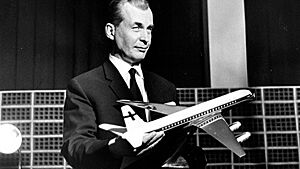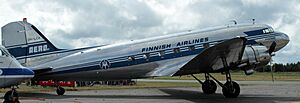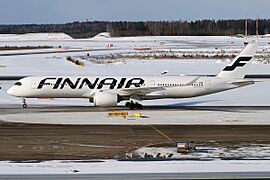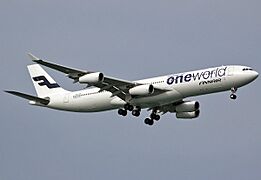Finnair facts for kids
A Finnair Airbus A350-900
|
|
| Founded | 1 November 1923 (as Aero O/Y) |
|---|---|
| Hubs | Helsinki Airport |
| Frequent-flyer program | Finnair Plus |
| Alliance | Oneworld |
| Subsidiaries |
|
| Fleet size | 80 (incl. Nordic Regional Airlines) |
| Destinations | 104 |
| Parent company | Finnair Group |
| Headquarters | Aviapolis, Vantaa, Finland |
| Key people | Turkka Kuusisto (CEO) |
| Revenue | |
| Operating income | |
| Net income | |
| Total assets | |
| Total equity | |
| Employees | 5,230 (31 December 2022) |
Finnair Plc is the main airline of Finland. It is based in Vantaa, right next to Helsinki Airport, which is its main hub. Finnair and its related companies are very important for both local and international flights in Finland. The Finnish government owns more than half of the company. Finnair is also part of a big group of airlines called Oneworld.
Finnair was started in 1923, making it one of the oldest airlines that is still flying today. It is also known as one of the safest airlines in the world. Its slogans are Designed for you and The Nordic Way.
Contents
Finnair's Journey Through Time
How Finnair Started
In 1923, a person named Bruno Lucander started Finnair. Back then, it was called Aero O/Y. The airline's code, "AY", comes from this original name. Lucander had worked with another airline before starting Aero O/Y. He made a deal with a company called Junkers to get planes and help. In return, Junkers owned half of the new airline.
The company officially began in Helsinki on December 11, 1923. The very first flight happened on March 20, 1924. It flew from Helsinki to Tallinn, Estonia, using a Junkers F.13 plane that could land on water. These water-plane services stopped in 1936 when the first proper airports were built in Finland.
Flying During World War II
World War II was a very hard time for Finnair. Cities in Finland were attacked from the air. Half of Finnair's planes were taken by the Finnish Air Force to help with the war. During the Winter War in 1939 and 1940, about half of the passengers flying from other Finnish cities were children. These children were being moved to Sweden for safety.
After the War: New Beginnings
After the war, the Finnish government wanted the airline to fly longer routes. So, in 1946, the government bought most of the company. Finnair started flying to Europe again in November 1947, using Douglas DC-3 planes. In 1953, the airline officially started calling itself Finnair. They also got faster Convair 440 planes, which helped them fly to places like London.
The Jet Age Arrives
In 1961, Finnair started using jet planes, beginning with the Caravelle. These jets were later swapped for improved Super Caravelles. In 1962, Finnair bought a large part of another Finnish airline called Kar-Air. The company's official name became Finnair Oy on June 25, 1968.
In 1969, Finnair got its first jet plane made in the United States, a Douglas DC-8. On May 15, 1969, Finnair started its first flights across the Atlantic Ocean to New York. During the 1960s, Finnair's main office was in Helsinki.
Finnair received its first large, wide-body planes in 1975. These were two DC-10-30 aircraft. The first one arrived on February 4, 1975. It started flying on February 14, 1975, on routes between Helsinki and New York, and later to Las Palmas.
In 1979, Finnair helped create a company called Finnaviation. This company was formed by combining two other smaller airlines. Finnaviation started flying regular domestic routes in October 1979. Finnair owned a big part of Finnaviation, and eventually, Finnaviation became fully part of Finnair.
Growing Bigger in the 1980s
In 1981, Finnair added new routes to Seattle and Los Angeles. In April 1983, Finnair became the first airline to fly non-stop from Western Europe to Japan. These flights went from Helsinki to Tokyo using a special McDonnell Douglas DC-10-30ER plane.
Normally, flights to Japan had to stop in places like Moscow or Anchorage because of rules about flying over Soviet airspace. But Finnair found a way around this by flying directly north from Helsinki, over the North Pole, and then south through the Bering Strait. This flight took about 13 hours. This gave Finnair an advantage because other flights with stops could take up to 16 hours.
In 1988, Finnair started a new route from Helsinki to Beijing. This made Finnair the first airline from Western Europe to fly non-stop between Europe and China. In 1989, Finnair was the first airline to order the McDonnell Douglas MD-11 plane. The first one was delivered on December 7, 1990. The first flight with the MD-11 was on December 20, 1990, from Helsinki to Tenerife.
New Airlines and Changes (1990s–2000s)

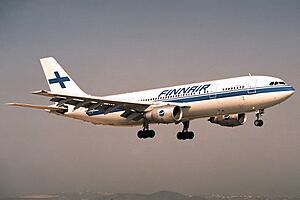
In 1997, the smaller airlines Kar-Air and Finnaviation became fully part of Finnair. On September 25, 1997, the company's official name changed to Finnair Oyj.
In 1999, Finnair joined the Oneworld airline alliance, which is a group of airlines that work together. In 2001, Finnair started a new airline called Aero Airlines in Tallinn, Estonia, using its old "Aero" name.
In 2003, Finnair bought a Swedish low-cost airline called FlyNordic, which flew mostly within Scandinavia. In 2007, Finnair sold FlyNordic to another airline, Norwegian Air Shuttle. As part of that deal, Finnair owned a small part of Norwegian Air Shuttle for a while.
On March 8, 2007, Finnair was the first airline to order the new Airbus A350 XWB planes. They ordered 11 of these planes, with the first ones arriving in 2015.
Recent Challenges and Changes
Finnair has faced some challenges, including disagreements with its workers. These happened because the airline tried to cut costs to compete with other airlines that offer cheaper flights.
In December 2011, Finnair handed over its baggage and ground services to another company called Swissport International.
In 2022, Finnair carried about 2.9 million passengers. This was much less than in 2019 because the COVID-19 pandemic caused many travel restrictions. At the end of 2022, Finnair had about 5,325 employees.
Since 2022, Russia closed its airspace, which meant Finnair could not fly over Russia. This forced Finnair to change many of its routes to Asia. In March 2023, Finnair announced it would stop domestic flights from Tampere and Turku to Helsinki. Instead, passengers could take a bus because the distance was short and not many people were flying these routes.
How Finnair Works
Business Information
Finnair Plc is the main company in the Finnair group. Its shares are traded on the Nasdaq Helsinki Stock Exchange. The main office is in Vantaa, near Helsinki Airport.
The government of Finland is the biggest owner of Finnair, holding 55.8% of its shares. No other single owner has more than 5% of the shares.
Finnair's Other Companies
Finnair Cargo
Finnair has two companies that handle its cargo business: Finnair Cargo Oy and Finnair Cargo Terminal Operations Oy. Their offices are at Helsinki Airport. Finnair Cargo uses Finnair's planes to carry goods.
Finnair Cargo has three main locations for its operations:
- Helsinki Airport: This is the main hub for Finnair Cargo. A new freight terminal opened here in 2017.
- Brussels Airport: Finnair Cargo has used Brussels Airport as a second hub for cargo. Now, it works with DHL Aviation for flights from Brussels.
- London Heathrow Airport: This is the newest hub for Finnair Cargo. Finnair works with IAG Cargo to fly to London Heathrow daily with Airbus A350 planes to carry extra cargo.
Nordic Regional Airlines
Finnair owns 40% of Nordic Regional Airlines (Norra). This airline uses ATR 72-500 and Embraer E190 planes, which are leased from Finnair and painted in Finnair's colors. Norra started flying on October 20, 2011. Since May 1, 2015, it has flown under Finnair's flight codes.
Finnair's Main Office
Finnair's main office is called the House of Travel and Transportation, or "HOTT." It is located near Helsinki Airport. This office opened in 2013, replacing an older office nearby. The building is very large, with lots of office space.
The previous airport office was used since 1994. Before that, Finnair's office was in central Helsinki. The old Helsinki office, which opened in 1972, was later turned into storage units.
How Finnair Looks

Plane Colors and Design
In December 2010, Finnair showed off a new look for its planes. The biggest changes included larger letters on the side of the plane, white engines, and a blue Finnair logo on a white tail fin. The old globe outline was removed from the tail.
Flight Attendant Uniforms
The current uniforms for flight attendants were designed by Ritva-Liisa Pohjalainen and introduced in December 2011. Finnair uses stripes on the sleeves or shoulders to show the rank of crew members. One stripe is for regular cabin crew, two stripes for Senior Cabin Crew, and three stripes for a Purser or Chief Purser. Some female Pursers also have a white stripe on their uniform to show how many years they have worked. Finnair requires its cabin crew to wear gloves during take-off and landing for safety.
Working with Other Companies
Finnair works with several other companies and airlines. These include Alaska Airlines, American Airlines, British Airways, Deutsche Bahn (DB) (a German railway company), Chinese JD.com, Japan Airlines, and Marimekko (a Finnish design company).
Where Finnair Flies
Finnair flies from its main hub in Helsinki to over 80 places in more than 35 countries. These destinations are in Asia, Europe, and North America. Finnair also flies to six cities in the United States. In the past, Finnair flew to places in Africa and South America for leisure trips. Finnair also has over 10 domestic destinations within Finland. These domestic flights are often operated with its partner airline, Nordic Regional Airlines.
In 2021, Finnair started five new routes from Stockholm–Arlanda to Bangkok–Suvarnabhumi and Phuket in Thailand, as well as New York–JFK, Miami, and Los Angeles in the United States. These routes have since stopped.
On February 28, 2022, Russia closed its airspace. This caused many changes for Finnair's flights to Asia. Most of Finnair's flights between Europe and Asia used to fly over Russia because it was the shortest and fastest way. To deal with this, on March 9, 2022, Finnair flight AY073 flew from Helsinki to Tokyo Narita by going over the North Pole. Finnair had flown over the North Pole before, back in 1983, when it was the first airline to fly non-stop from Europe to Japan using this route.
Finnair also started a new route to Dallas/Fort Worth in 2022. Flights to Seattle/Tacoma were also brought back in 2022.
Finnair shares flights, called codeshares, with many other airlines. This means you can book a flight with Finnair, but part of your journey might be on another airline's plane.
- Air China
- Air France
- Air Serbia
- Alaska Airlines
- American Airlines
- Bangkok Airways
- British Airways
- Cathay Pacific
- China Southern Airlines
- Fiji Airways
- Iberia
- Icelandair
- Japan Airlines
- Jetstar
- Juneyao Air
- LATAM Brasil
- LATAM Chile
- Level
- Malaysia Airlines
- Qantas
- Qatar Airways
- SriLankan Airlines
- TAP Air Portugal
- Turkish Airlines
- Vietnam Airlines
- Widerøe
Finnair also has special agreements called joint ventures with some airlines. This means they work even more closely together on certain routes.
- American Airlines
- British Airways
- Iberia
- Japan Airlines
- Juneyao Air
Finnair's Planes
Planes Finnair Uses Now
As of November 2024, Finnair uses the following types of planes:
| Aircraft | In service | Orders | Passengers | Notes | ||||
|---|---|---|---|---|---|---|---|---|
| J | W | Y | Total | Refs | ||||
| Airbus A319-100 | 5 | — | 14 | — | 130 | 144 | ||
| Airbus A320-200 | 10 | — | 14 | — | 160 | 174 | ||
| Airbus A321-200 | 15 | — | 16 | — | 193 | 209 | ||
| Airbus A330-300 | 8 | — | 28 | 21 | 230 | 279 | Refurbished with new Business and Premium Economy cabins. Two aircraft wet-leased to Qantas. |
|
| Airbus A350-900 | 9 | 1 | 43 | 24 | 211 | 278 | Refurbished with new Business and Premium Economy cabins. | |
| 9 | 30 | 26 | 265 | 321 | ||||
| ATR 72-500 | 12 | — | — | — | 68 | 68 | All leased to Nordic Regional Airlines. | |
| 72 | 72 | |||||||
| Embraer E190 | 12 | — | 12 | — | 88 | 100 | Operated by Nordic Regional Airlines. | |
| Total | 80 | 1 | ||||||
Pictures of Finnair's Current Planes
- Finnair current fleet
-
Airbus A350-941 in Moomin special livery
-
Embraer E190 operated by Nordic Regional Airlines
Types of Aircraft Finnair Uses
Smaller Planes for Shorter Flights
Finnair received its first narrow-body aircraft from Airbus, the Airbus A321, on January 28, 1999. Today, Finnair has up to 15 A321 planes. The first Airbus A319 arrived on September 20, 1999. Finnair uses Airbus A319, A320, and A321 planes for flights within Finland and to other European cities. Some A321 planes are also used for longer flights, like to Dubai.
The ATR 72-500 and Embraer E190 planes are flown by Nordic Regional Airlines. These are also used for domestic and European flights.
Airbus A330 Planes
Finnair got its first Airbus A330-300 planes on March 27, 2009. Now, it has eight of them. As of July 2023, these A330 planes are used for long flights from Helsinki to places like Delhi, Mumbai, New York, Chicago, Seattle, and Doha. These planes are also sometimes used for European flights to Brussels and Amsterdam.
Airbus A350 Planes
On March 8, 2007, Finnair officially ordered 11 Airbus A350 planes. On December 3, 2014, Finnair ordered eight more A350 planes, with deliveries starting in 2018. Finnair planned to use its A350 planes for flights to Bangkok, Beijing, and Shanghai starting in 2015. Flights to Hong Kong and Singapore were added in 2016.
As of April 2019, Finnair flies the Airbus A350 to many cities in Asia and North America. In January 2016, Finnair became the first European airline to fly the A350 to the United States. Finnair sometimes uses the A350 for morning flights from Helsinki to London–Heathrow to carry extra cargo. As of November 1, 2022, the A350 also serves the New Delhi route. In autumn 2024, Finnair started flying the A350 daily to Gran Canaria. Sometimes, it also flies to Amsterdam, Munich, and Brussels.
Finnair received its first A350 plane on October 7, 2015. This made it the third airline in the world to fly this type of aircraft. By 2022, Finnair had 19 A350 planes.
Future Plans for Finnair's Planes
Finnair plans to update its fleet of smaller planes. It aims to replace its older Airbus A320 family planes with newer models. Finnair expects to spend a lot of money on new planes between 2020 and 2025. The airline plans to have about 100 planes by 2025. Most of these will be smaller planes, and about 30% will be larger, wide-body planes.
Finnair has sometimes had too few planes. Because of this, it has rented planes from other airlines. For example, in March 2016, Finnair rented two Airbus A321 planes from Air Berlin for its European flights. These planes were used for flights to cities like Amsterdam, Berlin, and Paris.
Finnair's short-haul network also includes 24 regional planes flown by Nordic Regional Airlines. These are 12 ATR 72 and 12 E-190 planes.
Finnair had planned to remove two of its Airbus A330 planes by the end of 2017. However, this plan changed. Finnair decided to keep its A330 fleet even as new A350s arrived. These A330 planes are now expected to be retired sometime in the 2020s.
Special Designs on Planes
Finnair has some planes with special paint designs, called liveries. These include designs from Marimekko (like "Kivet" and "Unikko"), Oneworld alliance designs, and Christmas-themed "Reindeer" designs. In the past, Finnair also had special designs like "Moomins" and "Santa Claus".
| Plane ID | Design | Aircraft Type | Source |
|---|---|---|---|
| OH-LTO | Marimekko 50th Anniversary "Unikko" livery | Airbus A330-300 | |
| OH-LVD | Oneworld livery | Airbus A319-100 | |
| OH-LKN | Embraer E190 | ||
| OH-LWB | Airbus A350-900 | ||
| OH-LWL | Marimekko Kivet-livery | ||
| OH-LWO | Moomin-livery | Airbus A350-900 |
Old Planes Finnair Used to Fly
Finnair has used many different types of planes throughout its history. Some of these include:
- ATR 42-300 (1986–1990)
- ATR 72-200 (1995–2005)
- Airbus A300B4-200FF (1990–1998)
- Airbus A340-300 (2006–2017) – Replaced by Airbus A350-900.
- Boeing 737-200 (1989–1993)
- Boeing 757-200 (1997–2014) – Replaced by Airbus A321-200.
- Convair CV-340 (1953–1980)
- Convair CV-440 (1956–1980)
- de Havilland Dragon Rapide (1937–1939)
- Douglas C-47 Skytrain (1947–1969)
- Douglas DC-2 (1941–1949)
- Douglas DC-8-62 (1975–1984)
- Douglas DC-8-62CF (1969–1981)
- Embraer E170 (2005–2012)
- Fokker F27 Friendship (1980–1988)
- Junkers F.13 (1926–1939)
- Junkers G 24 (1926–1935)
- Junkers Ju 52/3m (1932–1945)
- McDonnell Douglas DC-9-14 (1971–1985)
- McDonnell Douglas DC-9-15 (1976–1988)
- McDonnell Douglas DC-9-41 (1981–1996)
- McDonnell Douglas DC-9-51 (1976–2003)
- McDonnell Douglas DC-10-30 (1975–1996)
- McDonnell Douglas DC-10-30ER (1981–1995)
- McDonnell Douglas MD-11 (1990–2010) – Finnair was the first customer for this plane. Replaced by Airbus A340-300.
- McDonnell Douglas MD-11F (2010–2011)
- McDonnell Douglas MD-82 (1983–2006)
- McDonnell Douglas MD-83 (1985–2006)
- McDonnell Douglas MD-87 (1987–2000)
- Saab 340 (1996–2000)
- Sud Aviation Caravelle III (1960–1965)
- Sud Aviation Caravelle 10B Super Caravelle (1964–1984)
Pictures of Finnair's Historical Planes
-
Airbus A340-300 in Oneworld livery
Flying with Finnair
Different Seating Areas
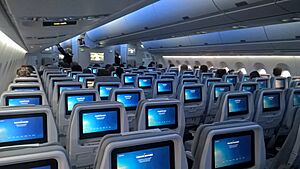
Business Class
Business class is available on all Finnair Airbus planes. On long-haul flights, these seats have personal screens for entertainment. The seats can recline into a flat bed, which is 78 inches long. In February 2022, Finnair introduced new business class seats for its long-haul flights. These seats are designed to let passengers choose many different sitting and sleeping positions.
Premium Economy Class
Premium economy is Finnair's newest seating option. It was introduced in February 2022. This class is available on the Airbus A330s and A350s.
In-flight Magazine
Finnair used to publish an English magazine called Blue Wings 10 times a year. The first issue came out in 1980. It stopped being printed in 2020 but was available online. As of 2023, Blue Wings was brought back as a physical magazine for Finnair's 100th anniversary.
Finnair's Environmental Efforts
In December 2018, Finnair flights leaving San Francisco started using sustainable aviation fuel. This was part of a project with the airport, Shell, and SkyNRG, aiming to make flying more eco-friendly.
Incidents and Accidents
- On November 16, 1927, a Junkers F.13 plane disappeared while flying from Tallinn to Helsinki. The pilot and two passengers were never found.
- On November 10, 1937, a Junkers Ju 52 flying from Turku to Stockholm lost its front engine over the sea. The pilots managed to land the plane safely, and no one was hurt.
- On June 14, 1940, a Ju 52 plane named Kaleva was shot down over the Gulf of Finland. All nine people on board died.
- On June 7, 1941, a Ju 52 plane that could land on water had to make an emergency landing because all three engines lost power due to bad fuel. The plane was recovered, but the two people on board drowned trying to swim to safety.
- On October 31, 1945, a Ju 52 crashed while trying to land at Hyvinkää. The plane flew too low because radio signals were unclear. All 14 people on board survived, but the plane was too damaged to fly again.
- On January 3, 1961, Flight 311 from Kronoby to Vaasa crashed while trying to land. All 25 people on board died. This is Finland's worst aviation accident.
- On November 8, 1963, Flight 217 from Helsinki to Mariehamn crashed while trying to land. The flight attendant and two passengers were the only survivors. The crash was likely caused by poor visibility and a faulty altimeter. 20 passengers and two crew members died. This was Finnair's last accident with fatalities.
- On September 30, 1978, Flight 405 from Oulu to Helsinki was taken over by a person. The plane flew to Helsinki, where some passengers were released. The plane then flew to Oulu, where the person received a large sum of money. The plane then flew to Amsterdam and back to Helsinki before returning to Oulu. The person released the remaining passengers and was later arrested.
- On December 23, 1987, Flight 915 from Tokyo to Helsinki was reportedly shot at by a missile over Svalbard. The missile supposedly exploded before hitting the DC-10. These events were not made public until 2014.
See also
 In Spanish: Finnair para niños
In Spanish: Finnair para niños



